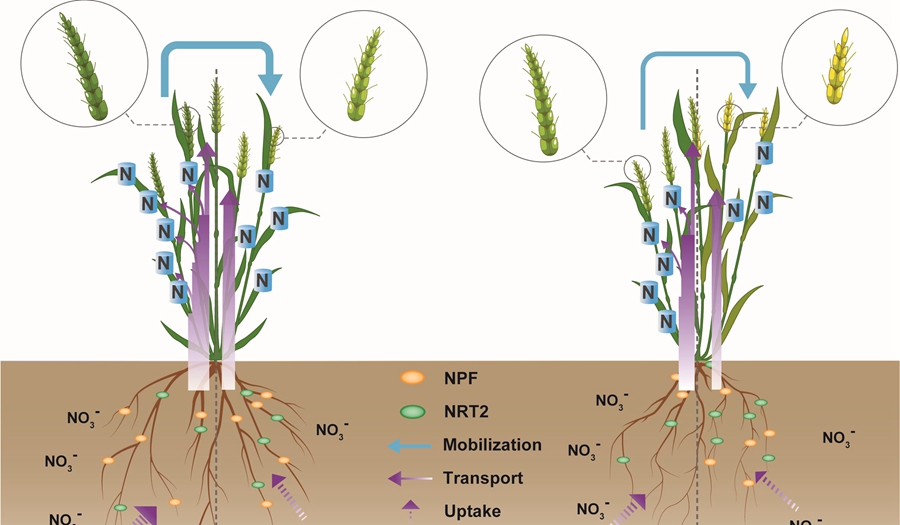A research team led by Prof. LING Hong-Qing from Institute of Genetics and Developmental Biology (IGDB), Chinese Academy of Sciences (CAS), together with collaborators from Ludong University and Computer Network Information Center, CAS, have successfully generated a high quality genome of Kenong 9204 (KN9204), a high nitrogen use efficiency (NUE) wheat cultivar bred in IGDB, and illustrated its possible molecular mechanisms driving the high NUE by comparative genome analysis. Results were published on line in Molecular Plant on July 21, 2022 (https://doi.org/10.1016/j.molp.2022.07.008).
Nitrogen (N) shortage is one of the most limiting factors in crop production, and approximately 60% of the fertilizer consumed in agriculture each year are N fertilizer. The increasing application of N fertilizers in agriculture has improved yield, while also causing serious environmental problems, such as the eutrophication of waterways and soil acidification. Common wheat (Triticum aestivum L.), as a staple food crop in the world, is cultivated on more land area than any other food crop. Therefore, improving the N use efficiency of wheat is very important for sustaining agriculture and protecting environment.
In this study, the researchers sequenced and assembled the genome of the high NUE wheat cultivar KN9204, did comparative analysis with the other known grass genomes, and found that the high affinity nitrate transporter (NRT2) gene family has expanded during wheat evolution. Further analysis confirmed that some of the expanded family members gained new functions, such as response to high salinity stress. Additionally, they also found that nitrate efflux transporter (NAXT) genes, which function in nitrate efflux in the root pericycle and in loading nitrate into the xylem sap, underwent expansion during the wild emmer formation. These findings can be the genetic basis for the wide adaptability of wheat to N deficiency in different geographical and soil environments.
By tanscriptome and gene coexpression network analysis, the researchers further identified key developmental stages and related important metabolic pathways of wheat in response to N deficiency. They found that N deficiency substantially suppressed the expression of cell division-related genes in young spikes of low-NUE wheat cultivar Jing 411, but had very weak effect on those genes in KN9204. Combined the gene expression with N accumulation data, they revealed that KN9204 possesses a higher N usage efficiency than that of ordinary wheat cultivar, especially in the reproductive development stage. Finally, the researchers concluded that the high NUE of KN9204 is an integrated effect controlled at different levels, such as robust and big root system, high expression of genes related to root development, nitrate uptake and transport.
This study provides new insights into the molecular mechanisms underlying high NUE in wheat and valuable genomic resources for creating high-NUE wheat cultivars. In addition, the 1RS rye chromosome short arm carried by KN9204 is an important material for studying wheat disease and stress resistance.
Model of the molecular mechanism underlying the high NUE of KN9204 and the effect of low nitrogen on the reproductive growth of the low-NUE wheat cultivar J411 (Image by IGDB)
Contact:
Dr. LING Hong-Qing
Institute of Genetics and Developmental Biology, Chinese Academy of Sciences
 Model of the molecular mechanism underlying the high NUE of KN9204 and the effect of low nitrogen on the reproductive growth of the low-NUE wheat cultivar J411 (Image by IGDB)Contact:Dr. LING Hong-QingInstitute of Genetics and Developmental Biology, Chinese Academy of SciencesEmail: hqling@genetics.ac.cn
Model of the molecular mechanism underlying the high NUE of KN9204 and the effect of low nitrogen on the reproductive growth of the low-NUE wheat cultivar J411 (Image by IGDB)Contact:Dr. LING Hong-QingInstitute of Genetics and Developmental Biology, Chinese Academy of SciencesEmail: hqling@genetics.ac.cn CAS
CAS
 中文
中文




.png)
